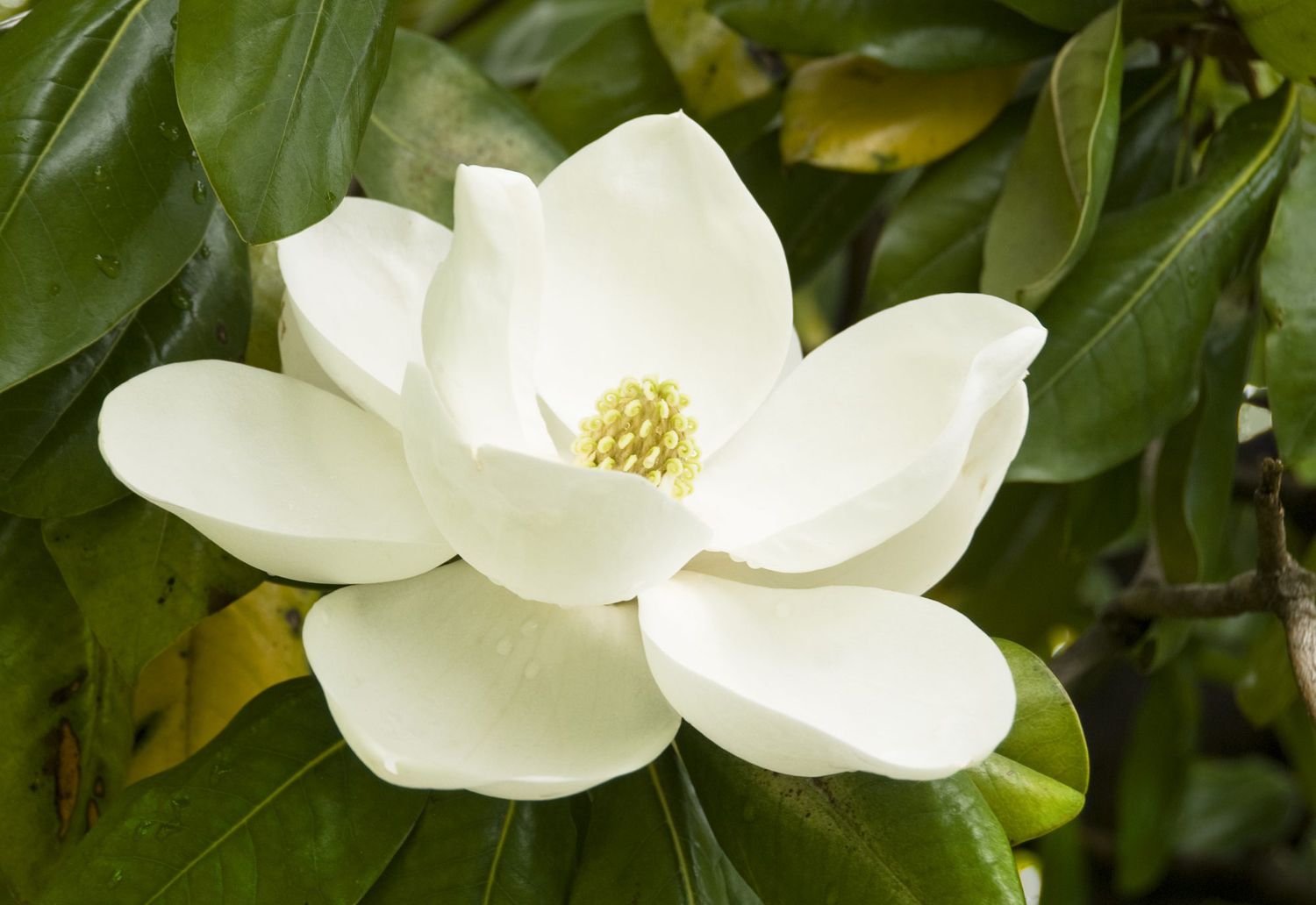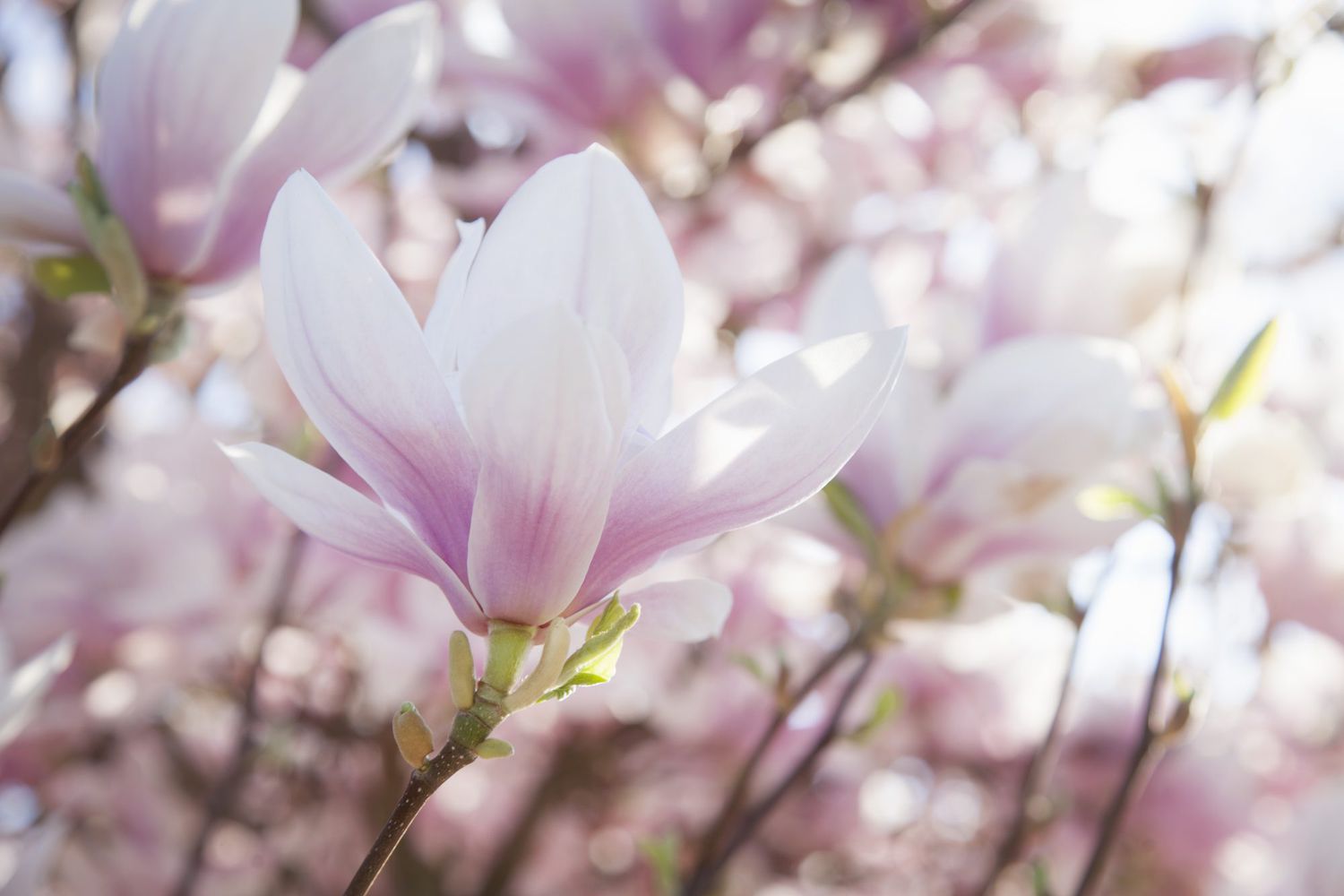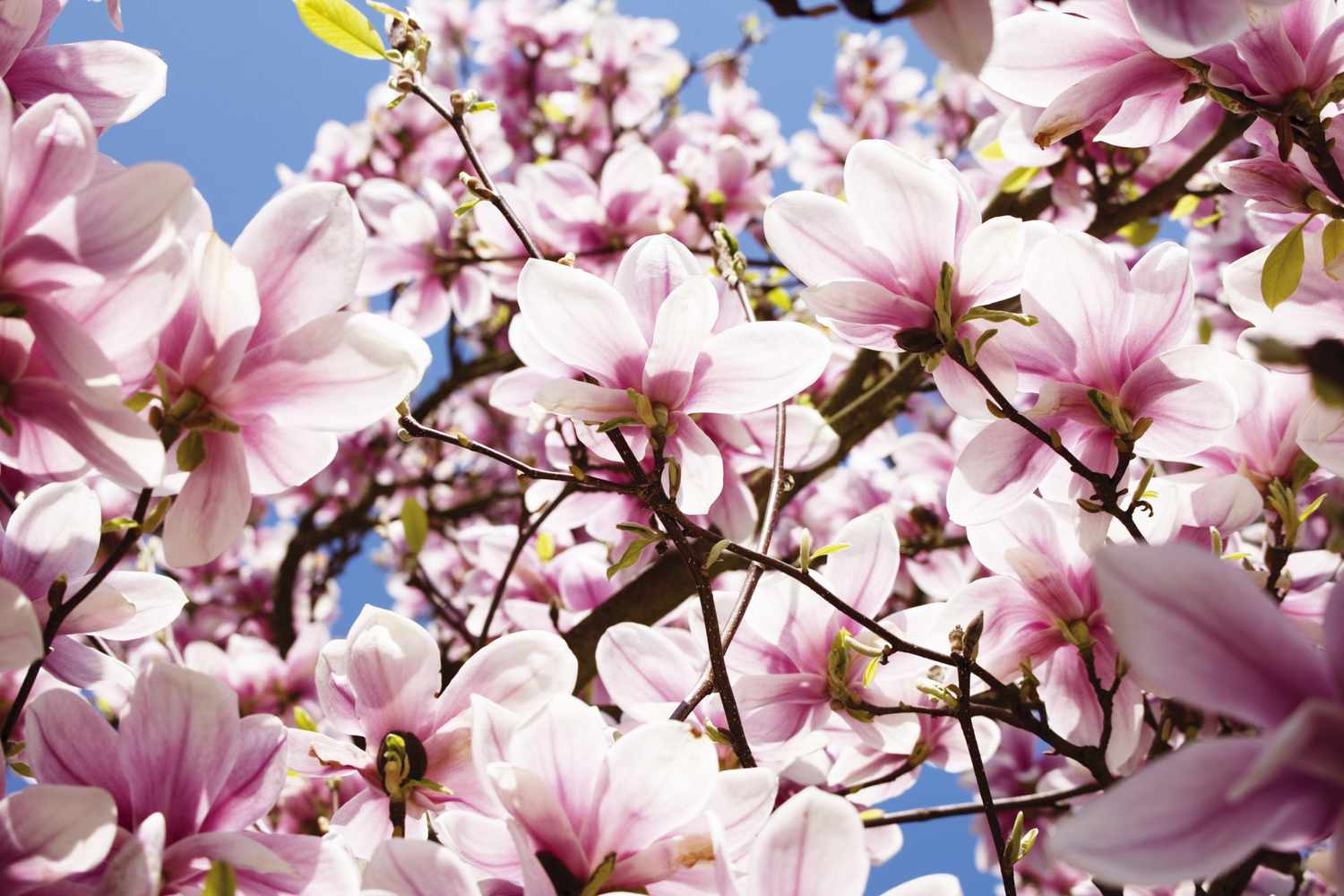Few plants can be considered as quintessentially Southern as the magnolia. Their big, waxy, glossy leaves juxtaposed with heady, fragrant flowers are familiar sights to Southerners. They bloom in ivory whites, pale yellows, and pretty pinks, with some species flowering in the heat of summer and others blooming in late winter as harbingers of warmer weather to come. These are favorite trees for Southern yards not only because of their perfumed blooms, which are always a draw for gardeners, but also because of their variety. Every gardener has their favorite, and we think there’s a magnolia species for every yard. If you don’t know which to grow, let us help you pick the right magnolia tree for you. Learn more about these Southern favorites below, with different species, hybrids, and selections that thrive across the varied climates of the South. Then read on for information about planting magnolias, establishing them, and tending them in your yard all year round.
Plant Attributes
| Common Name | Magnolia, saucer magnolia, tulip magnolia, Southern magnolia |
| Botanical Name | Magnolia |
| Family | Magnoliaceae |
| Plant Type | Tree and shrub |
| Mature Size | 20-80 ft. tall, 20-40 ft. wide |
| Sun Exposure | Full, partial |
| Soil Type | Moist but well-drained |
| Soil pH | Acidic, neutral, alkaline |
| Bloom Time | Spring, summer |
| Flower Color | Pink, white, yellow, purple |
| Hardiness Zones | 4-10 (USDA) |
| Native Area | North America, Asia |
Magnolia Tree Care
You can help your newly planted magnolias establish themselves in your yard by preventing soil compaction around the root zone. Try to keep foot traffic around the base of the tree to a minimum. Also, prune only when absolutely necessary. Magnolias seldom have serious pest or disease problems, so that shouldn’t affect your tree care. They’re also rarely browsed by deer or other wild garden visitors. Magnolias thrive in full sun or partial shade with regular water. Ensure your magnolia receives enough water and that it’s planted in well-drained soil. Few magnolias tolerate soggy soil. Sweet bay (M. virginiana) is an exception and can thrive in wet areas.
Light
Magnolia varieties prefer full sun to light shade. In warmer or dry climates, they appreciate some shade in the afternoon.
Soil
These trees grow best in moist, well-drained soil that is slightly acidic, but a range of pH levels offer suitable growing conditions for them. While they can adapt to sandy, loamy, and clay soils, magnolias do not grow well in soils with poor drainage.
Water
Once established, magnolias can be fairly drought-tolerant. Young trees need weekly watering until established. Gauge the tree’s water needs based on the temperature and rainfall in your area. Mulch around the base of the tree, but not near the trunk, will help.
Temperature and Humidity
Magnolia trees prefer warm and humid climates. Seedlings can be susceptible to frost damage. Some varieties, such as the Star magnolia (Magnolia stellata) do not tolerate heavy snow and ice well. Sweet bay magnolia (Magnolia virginiana) doesn’t have special temperature needs. Just plant it within the hardiness zone (USDA 4-10).
Fertilizer
Using fertilizer unnecessarily on some magnolias, like sweet bay, can cause fertilizer burn. Plant the tree in a hole three times wider than the root ball and fill it with the dirt from the hole. Use a slow-release, organic fertilizer like mulch for the best results.
Types of Magnolia Tree
Magnolias belong to the family Magnoliaceae. They’re deciduous and evergreen trees and shrubs that can most accurately be described as magnificent flowering plants. Magnolia trees are diverse in leaf shape and plant form, and they include both evergreen and deciduous sorts. They aren’t usually munched by deer. (An attractive characteristic for gardeners with yards where deer are known to browse.)
Magnolia hardiness varies by species, but most of them thrive in full sun or partial shade with regular water. Their summertime blooms are creamy and thick and their foliage varies from shiny and waxy (see: Magnolia grandiflora) to soft, green, enormous, and shaped like saucers (see: M. macrophylla, also known as bigleaf magnolia). Whether evergreen or deciduous, most magnolias have large, striking blossoms composed of petal-like segments. A few are grown for use as foliage plants. Some even grow big and thick enough to be used as privacy plantings and hedge-type tree plantings.
To help you out, we’ve classified magnolias by general type, including species, hybrids, and selections. New magnolias seem to appear almost hourly, but most garden centers carry only a few. To track down a prized selection, you’ll probably need to hunt through mail-order catalogs.

Evergreen Magnolias
To many people, the word «magnolia» is synonymous with our native Magnolia grandiflora, the classic Southern magnolia with large, glossy leaves and huge, fragrant white blossoms―the state flower of Mississippi and Louisiana. Few trees can match it for year-round beauty. It does, however, have its drawbacks. Unnamed seedlings often take 10 years after planting before they come into bloom. Dense shade and shallow roots make it impossible to grow grass beneath the canopy, and the roots often crack and lift pavement if the tree is planted between the sidewalk and curb. Though evergreen, the leaves of M. grandiflora can drop 365 days a year. Since the tree grows as wide as 40 feet and up to 80 feet tall, it takes up a lot of garden space. Newer selections like «Little Gem» only grow to 10 feet wide and 20 feet tall.
Sweet bay (M. virginiana), a smaller tree, is easier to fit into most gardens. Though mostly deciduous in the Upper and Middle South, it’s evergreen in the Lower and Coastal South and more cold-hardy than M. grandiflora.
New entries to this group are plants previously listed under the genus Michelia. These trees and shrubs hail from China and the Himalayas and are generally less cold-hardy than other evergreen magnolias, growing best in zone 8 or 9 and warmer. They’re renowned for their profuse, wonderfully fragrant flowers, which are borne among their leaves as opposed to the ends of the branches.
Popular selections include:
M. grandiflora: «Alta,» «Bracken’s Brown Beauty,» «D. D. Blanchard,» «Edith Bogue,» «Little Gem,» «Majestic Beauty,» «Samuel Sommer,» «St. Mary,» «Symmes Select,» «Teddy Bear,» «Timeless Beauty,» «Victoria»
M. virginiana: «Henry Hicks,» «Moonglow,» var. australis «Mardi Gras,» «Green Shadow,» «Sweet Thing,» «Tensaw»

Deciduous Magnolias With Saucer Flowers
This group includes the popular saucer magnolia (M. x soulangeana) and its myriad selections, often called tulip trees because of the shape and bright color of their flowers. They prefer fertile, acid, well-drained soil. They do not tolerate heavy wind or salt spray. Early-flowering selections are prone to frost damage. Related to these, but less tolerant of winter cold and summer heat, are the spectacular magnolias from western China and the Himalayas―Sargent magnolia (M. sargentiana) and Sprenger magnolia (M. sprengeri). Though their early flowers may fall victim to late freezes, one spring season with good blooms will quickly make you forget the disappointments of years past.
Popular selections include:
M. x soulangeana: «Alba Superba,» «Alexandrina,» «Black Tulip,» «Brozzonii,» «Lennei,» «Lilliputian,» «Rustica Rubra,» «Verbanica»
M. sprengeri: «Diva»

Deciduous Magnolias With Star Flowers
This group includes Kobus magnolia (M. kobus), Loebner magnolia (M. x loebneri), and star magnolia (M. stellata). All are cold-hardy, heat-tolerant, adaptable plants with fragrant flowers. The flowers have petals that branch out in forms resembling many-armed stars. Late frosts sometimes damage the early blooms of these magnolias. Several selections of star magnolias bear rosy pink blooms. M. stellata «Rosea» is also commonly known as «pink star magnolia.»
Popular selections include:
M. stellata: «Centennial,»Dawn,» «Royal Star,» «Two Stones»
Pink blooms: M. stellata «Rosea,» «Jane Platt,» «Rubra,» «Water Lily»

Other Magnolia Species
Less widely planted―but deserving of greater attention―is a group of large-leafed native magnolias generally grown as bold accents or shade trees. Cucumber tree (M. acuminata) and its smaller sibling, yellow cucumber tree (M. a. subcordata), are the source of the yellow blossom color of many new hybrids. Bigleaf magnolia (M. macrophylla), umbrella magnolia (M. tripetala), Fraser magnolia (M. fraseri), and Ashe magnolia (M. ashei) are medium-sized trees with huge leaves and large flowers that appear after the leaves unfurl. In its own category is Oyama magnolia (M. sieboldii), native to western China. It bears drooping, cup-shaped, fragrant blooms after leaves emerge.
Pruning
Prune magnolia trees to remove dead or damaged limbs and to maintain shape by shortening long branches. After flowering, use pruners or a pruning saw to shorten branches to where they join another branch. Branches cut from the bottom of a large southern magnolia tree will probably not grow back.
Propagating Magnolia Trees
The best time to propagate a magnolia is in the summer after its buds have set with cuttings from young growth.
- Use sharp pruners or a knife to cut a 6-inch piece from the tip of the branch. Immediately place the cutting in water. Remove the lower leaves, keeping a few upper leaves intact. Make a cut above a node.
- Dip the stem into a hormone rooting solution and plant the cutting into a 10- to 12-inch pot filled with moist, well-drained rooting medium.
- Place the pot in a bright location, cover it with plastic, and keep moist until the cutting develops a system of roots.
How to Grow Magnolia Trees From Seed
To grow a magnolia tree from seed, follow these steps:
- Collect seeds from fallen cones during the fall. Let the cones dry and open them to collect the seeds.
- Soak the seeds in warm water for 1-2 days to soften the seed coating.
- Remove the seeds from the water and dry them to remove the coating.
- Pack the seeds with moist peat moss in a plastic bag and refrigerate them during the winter.
- When outdoor temperatures reach 70 degrees, plant the seeds in the desired location in your yard. Mulch the seedlings well and protect them during the first few winters.
Planting Magnolia Trees
For any magnolia, be sure to pick your planting site carefully. Virtually all types are hard to move once established, and many grow quite large, which makes them nearly impossible to move later. The best soil for magnolias is fairly rich, well-drained, and neutral to slightly acid; if necessary, add generous amounts of organic matter when planting. Southern magnolia (M. grandiflora) is good for planting at the beach, though not on dunes. It can stand up to some salty sea breezes. Sweet bay (M. virginiana) tolerates wet soil. The species and selections listed are adapted to a wide range of growing conditions and are easy for most gardeners to grow.
Magnolias never look their best when crowded, and they may be severely damaged by digging around their roots. Larger deciduous sorts are most attractive standing alone against a background that will display their flowers at bloom time and show off their strongly patterned, usually gray limbs and big, fuzzy flower buds in winter. Small deciduous magnolias show up well in large flower or shrub borders and make choice ornaments too. Most magnolias are excellent lawn trees; try to provide a good-size grass-free area around the trunk, and don’t plant under the tree.
Balled-and-burlapped plants are available in late winter and early spring; container plants are sold all year. Do not set plants lower than their original soil level. Stake single-trunked or very heavy plants to prevent them from being rocked by the wind, which will tear the thick, fleshy, sensitive roots. To avoid damaging the roots, set stakes in the planting hole before placing the tree.
How to Get Magnolia Trees to Bloom
It can take several years for a young magnolia tree to bloom, especially if it was an unnamed, generic variety when purchased. Look for magnolia selections that are named, as they bloom earlier, or buy a tree with blooms or buds already on it.
Common Problems with Magnolia Trees
Magnolias have relatively few issues with pests and disease, but there are some fungal diseases you may encounter with a magnolia that can be treated.
Leaf Spot
Yellowing, early dropping, or small black or brown spots on magnolia leaves indicate leaf spot, which is a common disease that doesn’t cause significant damage or require treatment. Remove any affected fallen leaves to keep the problem under control.
Dead Branches
If you notice a branch dies suddenly while the rest are healthy, the fungal disease canker may be to blame. Prune the dead branch along with a few inches of new growth, and dispose of the affected branch properly.
Leaves Turning Yellow
If a white powder is present on the leaves, the magnolia tree may drop yellowed leaves early in the season. Apply a horticultural oil or neem oil to help control the powdery mildew.
Sooty Mold
Velvety black growth on the leaves means sooty mold is present. Spray water across the surface of the leaves to wash it away, or treat more severe cases with horticultural oil.
Frequently Asked Questions
-
What are magnolias known for?
According to arborday.org, magnolia trees have large, showy, and fragrant flowers. The magnolia tree’s bark is soft and light, used to create furnishings and other wood objects.
-
Can you grow a magnolia tree indoors?
Magnolia trees grow well in containers if you provide proper care, including a large container to support the roots and select the appropriate variety. Selections include the Star Magnolia (Magnolia stellata), «Ann» Lily Magnolia (Magnolia liliflora), or the «Henry Hicks» Sweet Bay Magnolia (Magnolia virginiana).